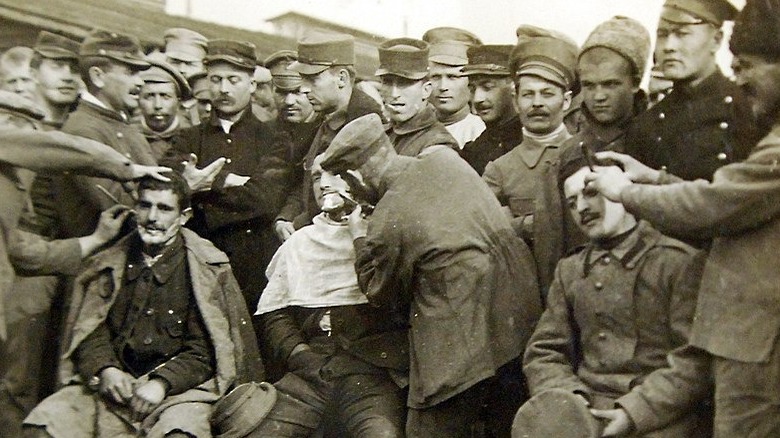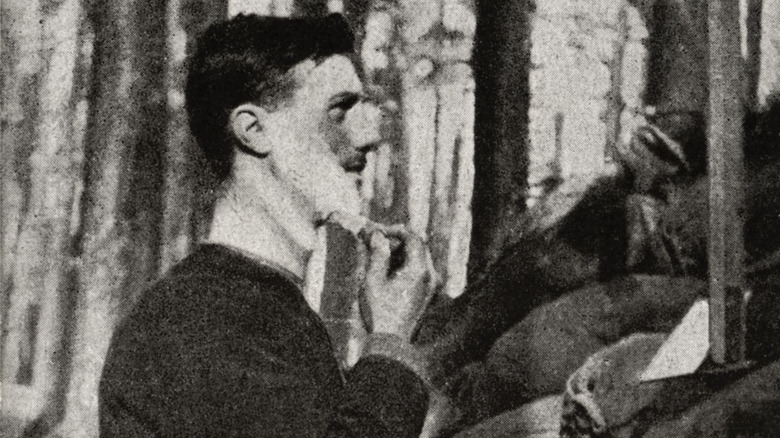How A Shaving Razor Spelled Doom For A US Congressman In 1921
When we imagine how we'll ultimately meet our makers, many envision slipping peacefully away in their sleep. Others picture saying goodbye to their loved ones. While many of us want to be fondly remembered for our actions and accomplishments in life, few want to be remembered for how they died.
Even fewer people, if any, could fathom dying as a result of a botched morning routine. For Michael Francis Farley, one of the more obscure senators in U.S. history, his demise was as unexpected as it was sudden.
Hailing from a rural Irish town, Farley emigrated from Birr in County Offaly, Ireland to chase the American Dream in New York in 1881, aged just 18. Farley would transcend these humble origins to become a prosperous proprietor of a tavern, eventually ascending the ranks of American society to become an elected senator of the Democratic Party in 1915 (per Congress Biographical Directory).
Unfortunately for Farley, his tenure as an elected congressman would prove short-lived, as he only served two years during Woodrow Wilson's administration before losing his seat in 1917. This brief career in Congress was cut short due to accusations of him prioritizing his pub over the public. His eventual successor, the famed eccentric Fiorella LaGuardia, even lambasted him in public as the ”sitting senator” due to his lack of a splash in the Senate (via History of the House).
Death Was In The Air
By the time Farley lost his re-election effort in 1917, the American zeitgeist was filled with death and despair. Although the eventual horrors that emerged from the senseless slaughter came to define World War I, the war itself resulted in the unanticipated spread of several infections to civilians, including anthrax.
While many people today can recall the horrific anthrax attacks in 2001, the truth is that anthrax, once known as woolsorter's disease, has been documented in humans for centuries and its transmission isn't always malicious. Cutaneous anthrax (the most frequent kind) occurs when anthrax bacteria enter the body through a break or cut in the skin.
The anthrax bacterium is transmitted to individuals through animals that have come into contact with it in the soil. As a result, it was dubbed woolsorter's disease since many people contracted it while handling contaminated animal wool, hides, or hairs (per the Centre for Disease Control). According to the Smithsonian, many men in the trenches of World War I contracted anthrax by shaving with unsanitary hairbrushes, as it was widely assumed that being clean-shaven made a soldier's gas mask more effective.
Furthermore, anthrax constituted a significant threat to the civilian population in the United States, who had nothing to do with overseas fighting. Generally, shaving brushes were fashioned from badger hair imported from Russia but sterilized en route through Germany or France. However, the Great War disrupted many travel and trade routes, resulting in unsterilized horsehair being marketed as badger hair instead, which had lethal consequences (via National Library of Medicine).
The Death of Michael F. Farley
The United States Congress was eager to impose restrictions on imported animal products during the war to prevent an outbreak. These considerations, however, would be too late for Michael Farley. Farley had unwittingly shaved three days before his death with a newly imported brush tainted with anthrax spores, according to his obituary in The New York Times. According to the CDC, cutaneous anthrax is the least lethal form of anthrax since most people who catch it recover with proper medical attention.
However, because the disease takes anywhere from one day to a week to exhibit symptoms, timing is crucial. Farley first spotted a "little pimple on the left side of his neck" on a Thursday, according to his friend A. Loman, a hatter who had given Farley a lift to the fair that day. Farley's neck had swollen by Friday, and despite his friends' protests, he refused to go to the hospital to have it checked out.
By Saturday, Farley's entire face had swollen to the point where he could scarcely speak, and he was rushed to the hospital. Despite receiving multiple anti-anthrax injections from doctors, Farley eventually fell into a coma and succumbed to the sickness, dying six hours after arriving at the hospital on August 8, 1921. Farley, who was survived by his widow, was eventually laid to rest in New York's Calvary Cemetery (via Find A Grave). His shocking, sudden death lent momentum to the public health movement to prohibit the importation of animal hair and hide products.


